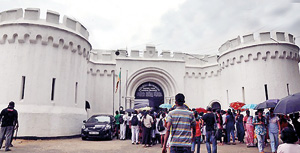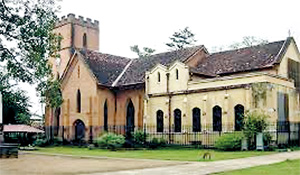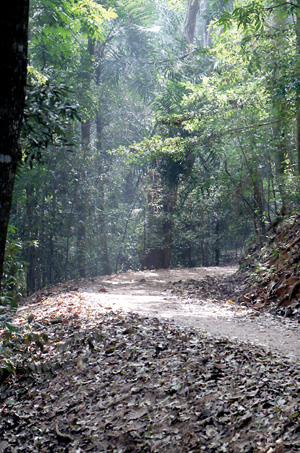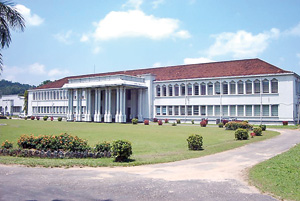The hill city of Kandy
 The city of Kandy is called the “hill city” and the cultural centre of Sri Lanka. It is situated in a valley, surrounded by the central mountain ranges of Hunnasgiriya and Hantane. Although Kandy is situated in a valley, it is still 500m above sea level. This means that although most of Sri Lanka has tropical weather which makes you feel warm and sweaty, Kandy is (almost) always nice and cool. Rainy weather can sometimes make Kandy a little unpleasant, but on a normal day, it’s perfect for exploring the city, sightseeing, adventuring in the surrounding forests or just going out to picnic and read a good book.
The city of Kandy is called the “hill city” and the cultural centre of Sri Lanka. It is situated in a valley, surrounded by the central mountain ranges of Hunnasgiriya and Hantane. Although Kandy is situated in a valley, it is still 500m above sea level. This means that although most of Sri Lanka has tropical weather which makes you feel warm and sweaty, Kandy is (almost) always nice and cool. Rainy weather can sometimes make Kandy a little unpleasant, but on a normal day, it’s perfect for exploring the city, sightseeing, adventuring in the surrounding forests or just going out to picnic and read a good book.
Not everyone likes history, but Kandy has so many exciting stories from her ancient past that it’s impossible not to want to hear more. For example, when the Portuguese and then the Dutch occupied Sri Lanka (then known as Ceylon), Kandy was the only city they couldn’t overthrow, because it was so well protected by the mountains. Even when the British finally managed to conquer the last Sri Lankan kingdom, it was after failed attempts. The army couldn’t get through the forested mountains and ended up with many contracting malaria and finally giving up the invasion.
Sri Dalada Maligawa
 Because Kandy was the last seat of the kings of Sri Lanka, their most prized possessions were also brought here from around the country as the Dutch and Portuguese took over. One such possession which is still highly valued today is the sacred tooth relic of the Gautama Buddha. The relic is placed inside a golden casket and kept in the Sri Dalada Maligawa, which used to be the royal dwelling place of the last kings of Sri Lanka.
Because Kandy was the last seat of the kings of Sri Lanka, their most prized possessions were also brought here from around the country as the Dutch and Portuguese took over. One such possession which is still highly valued today is the sacred tooth relic of the Gautama Buddha. The relic is placed inside a golden casket and kept in the Sri Dalada Maligawa, which used to be the royal dwelling place of the last kings of Sri Lanka.
The Maligawa is a beautiful structure, with ornate paintings and carvings decorating every wall and ceiling. Day in and day out, it is filled with the sounds of quiet drums and chimes, and the chanting of pirith. Pilgrims from all around the world stream through the great halls, burning incense, offering flowers and paying homage to the relic.
 Bogambara Prison Complex
Bogambara Prison Complex
The prison was built in 1876 by the British Ceylon Government. It was used to house serious offenders and death row prisoners. The complex which has gallow, is one of the two prisons in Sri Lanka where the death penalty was implemented. The gallows were shifted from Hangman’s Hill to Bogambara in 1876.
The building is one of the oldest existing buildings in the world heritage city of Kandy, and is considered to be a rich archaeological landmark. It is also believed the construction of the Prison has been done similar to the that of Bastille. It is now no longer a prison.
 St. Paul’s Church
St. Paul’s Church
After they took over the city, the British instituted their own traditions in Kandy, and one of these was the practice of Christianity.
A beautiful result of this was the building of St. Paul’s Church. It is an impressive red-brick structure, decorated with traditional stained-glass and one of the oldest pipe organs in Sri Lanka. Just like the Maligawa and the Bogambara prison, St. Paul’s Church has also seen the violence of war, when in 1998 it was damaged during an LTTE bomb-blast on the Maligawa.
 Udawatta Kele Sanctuary
Udawatta Kele Sanctuary
Constant visitors at the Maligawa and St. Paul’s are not just people coming to worship and sightsee, but also lots of monkeys! Most of these chattering bands of furry creatures live in the Udawatta Kele Sanctuary that rises behind the Maligawa and St. Paul’s.
Udawatte Kele is a forest reserve that spreads over 103 hectares (the size of more than 100 international standard athletic tracks put together!) on the hill ridges surrounding Kandy. It is a favourite spot for scientists around the world because it contains thousands of interesting plant specimens. Many interesting mammals, reptiles and birds also call the sanctuary home, making it an interesting place for anyone who likes wildlife, and to take hikes and walks.
Royal Botanical Gardens
If the idea of a forest with reptiles and insects sounds too icky or scary, then the next best (or better!) thing is the Royal Botanical Gardens in Peradeniya. “The Gardens” are full of the most beautiful flowers, trees, ponds, and landscaped gardens. It’s a great place for walks, picnics, tree-climbing and
run-around-and-have-crazy-fun times!
The Botanical Gardens also has a great history starting in the 1300s, all the way to 1901 when King George V and Queen Mary of the United Kingdom visited and planted the “Cannonball Tree”. During World War II, the garden was used by Lord Louis Mountbatten as the headquarters of the South East Asia Command.
 University of Peradeniya Campus
University of Peradeniya Campus
A few minutes away from the gardens in Peradeniya is the University campus. This is the widest-spread university campus in all of South Asia, spread across more than 700 hectares of land.
Most of this land is still forest area. The parts of the campus which are used by the university consist of majestic buildings decorated with unique stone-masonry, situated on vast landscaped gardens.


